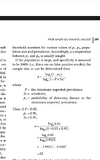The Filipino Vet Student
New Member
- Joined
- Jan 31, 2023
- Messages
- 5
- Reaction score
- 0
Hi! I am a fifth year veterinary student at Aklan State University, Banga, Aklan. Currently, I am working on a draft for a thesis proposal (though I am still at the RRL phase) which is about the intestinal helminths of Eurasian Tree Sparrows in Panay, Philippines. Sadly, publications about the parasitology of the aforementioned species, I think, are scarcely available in the Far East. But I somehow managed to find few yet very useful literatures. However, there is one thing that I am not able to do, the STATISTICS. I have poor knowledge when it comes to the statistical aspect of research. And EPIDEMIOLOGY, may it be human or veterinary, is basically STATISTICS.
In my thesis proposal, I chose 'point prevalence' as a measurement mainly because I find it simple, quick, cost-effective, and I have not found a single study about wild bird helminthology in my locality. Thus, using a prevalence study may be a good start. Anyhow, I presented my proposed study to my instructor. And I was asked to work out the statistical justifications for the sample size.
Now my question is: what is the required sample size for point prevalence? And what is the appropriate data analysis? Thank you for your help!
In my thesis proposal, I chose 'point prevalence' as a measurement mainly because I find it simple, quick, cost-effective, and I have not found a single study about wild bird helminthology in my locality. Thus, using a prevalence study may be a good start. Anyhow, I presented my proposed study to my instructor. And I was asked to work out the statistical justifications for the sample size.
Now my question is: what is the required sample size for point prevalence? And what is the appropriate data analysis? Thank you for your help!

